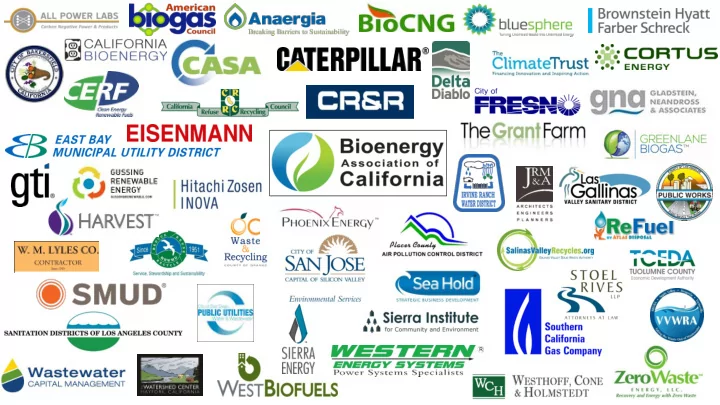

California Renewable Gas Policy • Why Biogas is So Important • Regulatory framework and barriers • Changes Needed
Why Biogas Matters So Much • Reduce Short-Lived Climate Pollutants ✓ Reduce black carbon from wildfire and diesel emissions ✓ Reduce methane from dairies, landfills, other organic waste • Reduce catastrophic wildfire • Reduce air pollution • Reduce landfilling
Biogas Provides: • Flexible generation, renewable power • Lowest carbon fuels and renewable hydrogen • Renewable gas for heating, cooling, cooking, industrial and purposes • Lots of Jobs
Potential Biogas Production in CA • 350 billion scf (10 million m³) biogas per year = 5-6,000 MW of flexible generation, renewable power, or = 3 Billion gallons of low carbon fuels ➢ enough to replace 90% of diesel used in CA
Million Gasoline Amount Technically Billion Cubic Feet Feedstock Gallon Available Methane Equivalents Landfill Gas 106 BCF 53 457 Animal Manure 3.4 M BDT 19.5 168 Waste Water Treatment Gas 11.8 BCF 7.7 66 Fats, Oils and Greases 207,000 tons 1.9 16 Municipal Solid Waste (food, 1.2 M BDT 12.7 109 leaves, grass) Municipal Solid Waste 6.7 M BDT 65.9 568 lignocellulosic fraction) Agricultural Residue 5.3 M BDT 51.8 446 (Lignocellulosic) Forestry and Forest Product 14.2 M BDT 139 1,200 Residue BIOGAS POTENTIAL 351 3,030 Source: Rob Williams and Stephen Kaffka, UC Davis, presentation to the California Energy Commission on January 30, 2017
Policies to Increase Biogas in California Renewable Electricity • AB 2196 – RPS preference for instate biogas • SB 1122 – 250 MW of small-scale bioenergy • SGIP and NEM • Governor’s Emergency Order • SB 840 – BioMAT interconnection Pipeline Access • AB 1900 – pipeline biogas standards and incentives • SB 840 – CCST/CPUC must reconsider BTU and siloxanes • AB 2313 – increases incentives for pipeline biogas interconnection
Policies to Increase Biogas (cont’d) Low Carbon Fuel Standard • Incentives based on carbon intensity • No long term contracts • ARB proposing technology specific changes, moving away from fuel/technology neutrality Renewable Hydrogen • SB 1505 – 33% renewable hydrogen requirement
SB 1383 (Lara, 2016) • Requires 75% diversion of organic waste by 2025 • Creates incentives for dairy biogas • Requires CEC to recommend policies to increase renewable gas • Other agencies must adopt those policies and incentives • CPUC must also adopt policies and incentives
How Much is CA Using Now? CA Biogas Potential Potential Actual Use
Barriers to Instate Biogas • Public Misconceptions • Technology / policymaker bias • Failure to monetize benefits • Misaligned Incentives • No long-term market certainty
Policies and Incentives Needed • Long-term market certainty • Pipeline and transmission access • Technology neutral policies and definitions • Increase R&D • Monetize benefits of biogas • Align incentives with policy priorities
THANK YOU Julia Levin, Executive Director jlevin@bioenergyca.org 510-610-1733 www.bioenergyca.org
Recommend
More recommend